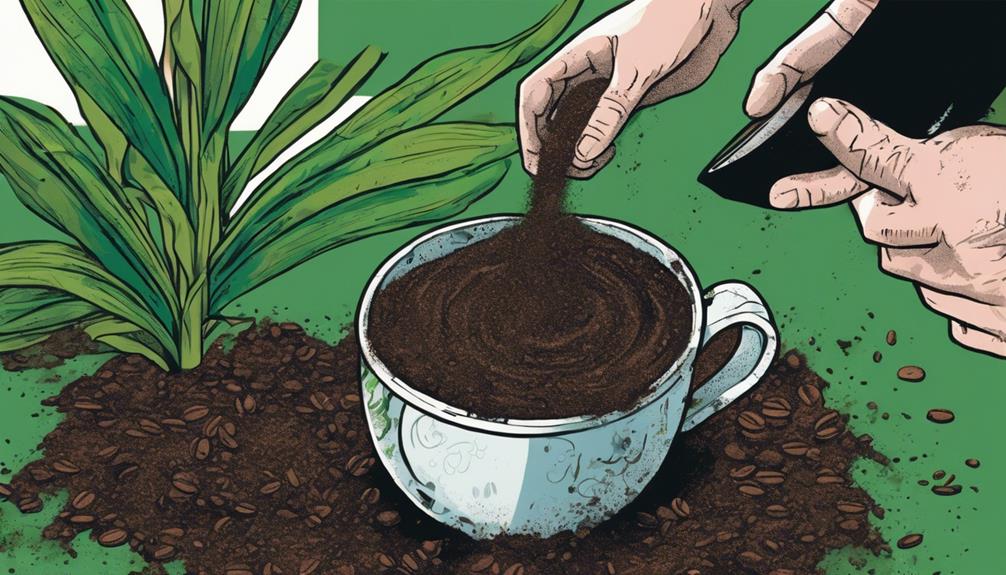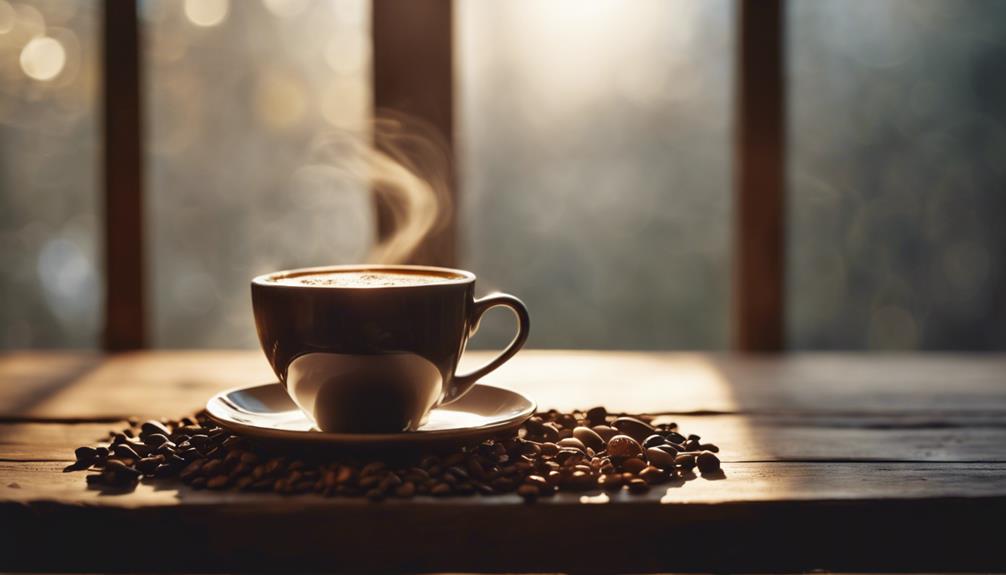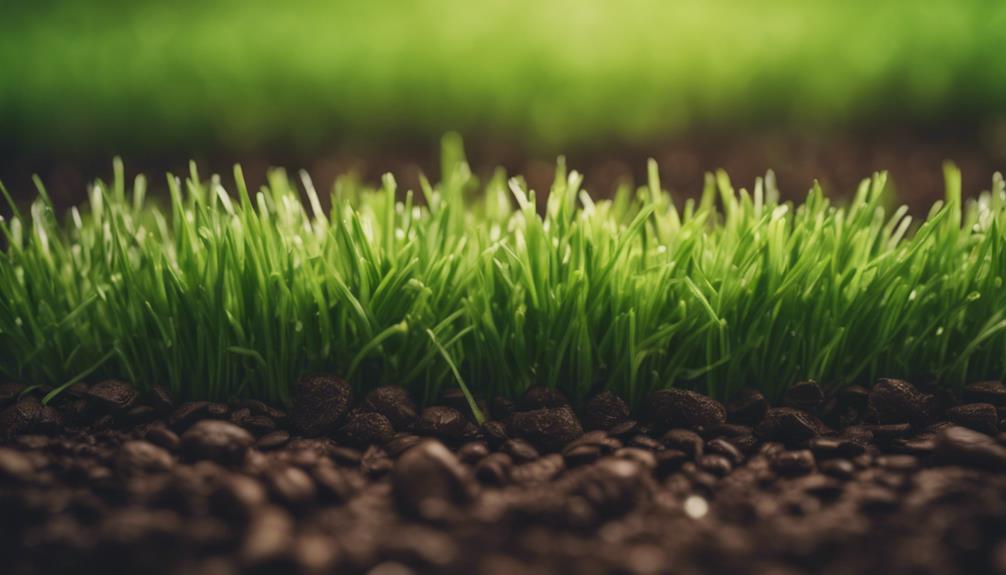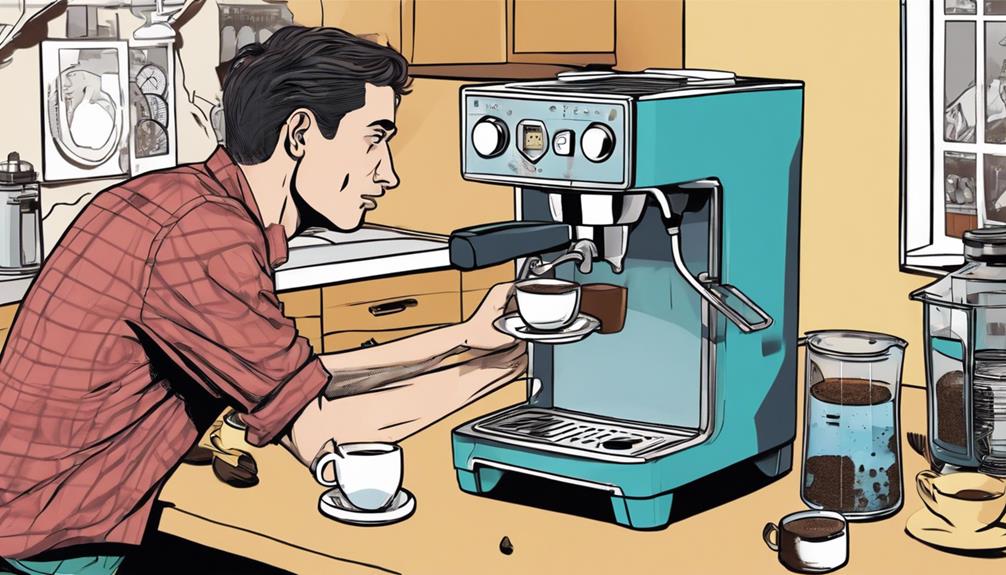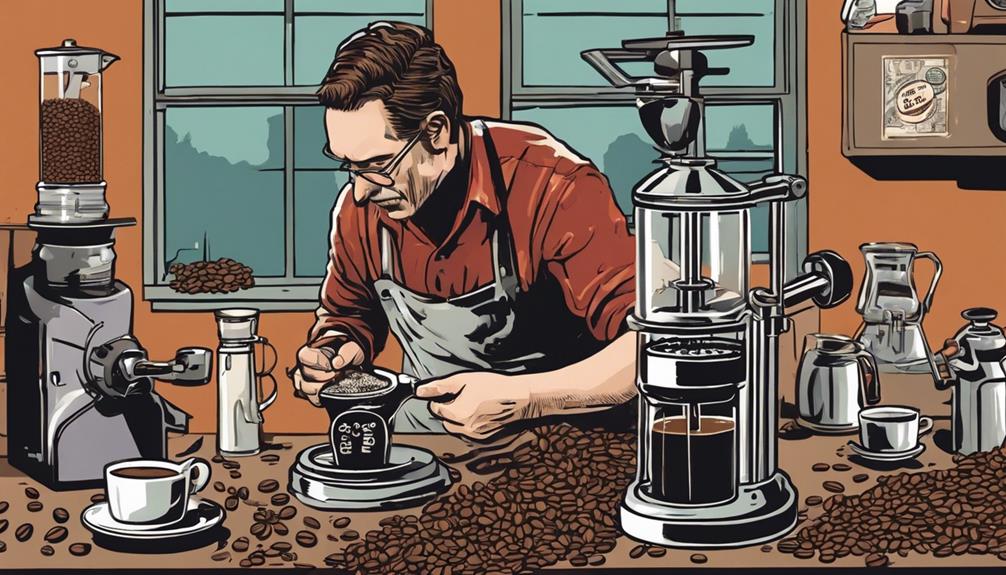Improve your orchid care by incorporating coffee grounds, but be cautious of potential risks. To prevent root rot, avoid excessive use of grounds and ensure the growing media is well-drained. Keep in mind that coffee may impede nutrient absorption, so be mindful of soil microorganisms. Over time, pH levels could decrease, negatively impacting growth. Take care to prevent acidity issues when using coffee grounds as a pest repellent to maintain your orchids’ health. It is important to know which orchids benefit the most from coffee grounds. Use them sparingly, maintain proper drainage, and monitor pH levels to ensure successful growth. Additional information is available to assist you in providing optimal care for your orchids!
Key Takeaways
- Use coffee grounds sparingly to prevent root rot and suffocation.
- Ensure proper drainage in orchid pots to avoid moisture retention risks.
- Top dress with coffee grounds for natural pest control benefits.
- Monitor pH levels regularly to prevent media acidification.
- Consider orchid types' needs when applying coffee grounds.
Moisture Retention Risks
Beware of the moisture retention risks linked with applying coffee grounds to your orchids, as they can result in root rot and suffocation.
When coffee grounds are used in orchid media, their capacity to retain moisture becomes a double-edged sword. While some moisture is crucial for orchid growth, excessive dampness from coffee grounds can create a breeding ground for root rot.
The fine granules of coffee grounds can compact and block air passages in the media, depriving the roots of much-needed oxygen. This suffocating environment can hinder root breathing and lead to the drowning of orchids in overly moist conditions.
To prevent these moisture-related issues, it's essential to maintain proper drainage in the orchid media when incorporating coffee grounds. By carefully managing the moisture levels in the orchid's environment, you can help safeguard your plant from the dangers of root suffocation and rot caused by coffee grounds' moisture retention properties.
Nutrient Uptake Challenges
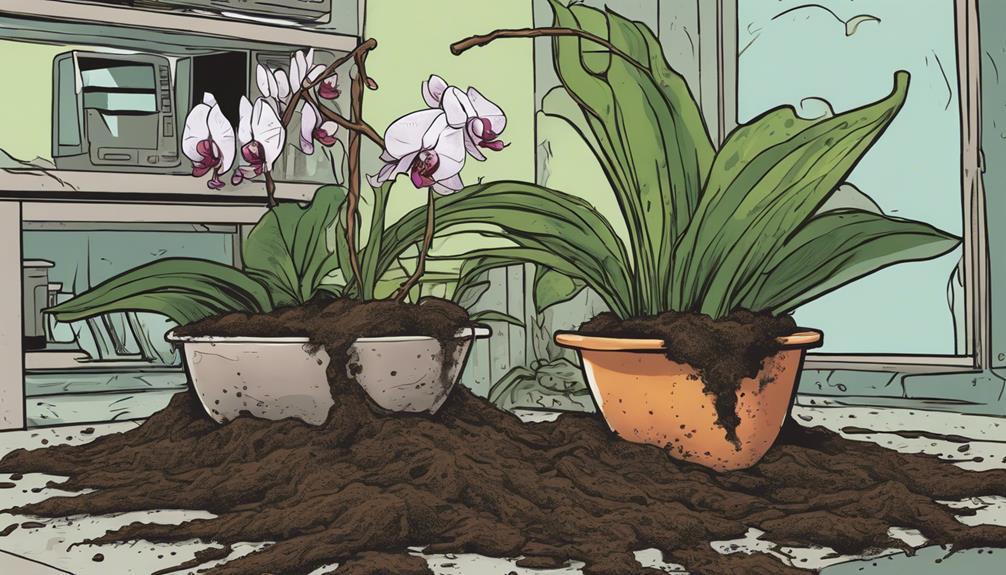
You face nutrient uptake challenges when applying coffee grounds to orchids due to the need for soil microorganisms to facilitate nutrient absorption.
Orchids in traditional mixes may lack the necessary microorganisms for breaking down coffee ground nutrients efficiently.
Understanding the importance of ammonium in the soil is essential for aiding the conversion of coffee ground nutrients for best orchid uptake.
Nutrient Breakdown Process
Soil microorganisms play a crucial role in facilitating the breakdown of nutrients in coffee grounds for optimal absorption by orchids. Coffee grounds are rich in nitrogen, providing a valuable nutrient source for plants. However, the nitrogen in coffee grounds isn't readily available for orchids; it requires the assistance of soil microorganisms to convert it into forms that the plants can effectively uptake.
Ammonium, present in the soil, aids in transforming the nitrogen from coffee grounds into a usable form for orchids. Surprisingly, earthworms, which are often absent in traditional orchid mixes, contribute to making the nutrients in coffee grounds more accessible to plants.
Potted orchids may face challenges in nutrient uptake due to the lack of necessary microorganisms in their environment. Ensuring a healthy population of soil microorganisms is crucial for orchids to benefit from the nutrient-rich coffee grounds effectively.
Microorganism Role Clarification
To clarify the role of microorganisms in nutrient uptake challenges, understanding their essential function in breaking down coffee ground nutrients for orchids is crucial. Microorganisms are necessary for converting complex nutrients in coffee grounds into forms that orchids can easily absorb. Without these tiny helpers, orchids would struggle to access the necessary nutrients for healthy growth. One key aspect is how microorganisms facilitate the breakdown of coffee ground nutrients, making them readily available for orchids to absorb efficiently.
Let's explore a table that highlights the relationship between microorganisms, nutrients, and orchids:
| Aspect | Role | Importance |
|---|---|---|
| Microorganisms | Break down coffee ground nutrients for orchid uptake | Essential for nutrient availability and absorption |
| Nutrients | Found in coffee grounds | Require transformation by microorganisms for orchids |
| Orchids | Rely on microorganisms for nutrient uptake | Require assistance to access nutrients from coffee grounds |
Understanding how microorganisms assist in nutrient uptake challenges is crucial to successfully utilizing coffee grounds for your orchids.
Ammonium Significance in Uptake
Ammonium plays a fundamental role in facilitating the absorption of nutrients from coffee grounds by orchids. Orchids require this nutrient in the soil to assist in the transformation of the nutrients present in coffee grounds into forms that they can utilize.
The presence of soil microorganisms is necessary for breaking down the nutrients in coffee grounds, making them more accessible for orchid uptake. However, in potted orchids where earthworms, which are typically responsible for fostering soil microorganisms, are absent, there may be a deficiency in the necessary organisms for processing the nutrients from coffee grounds.
Ammonium assists in converting these nutrients into a form that orchids can readily uptake, contributing to their overall growth and health. Without the support of soil microorganisms, the availability of nutrients from coffee grounds for orchids is limited, potentially hindering their best development.
To ensure the presence of ammonium and foster a healthy soil microbial community is critical for maximizing the benefits of using coffee grounds as a nutrient source for orchids.
Acidification Concerns
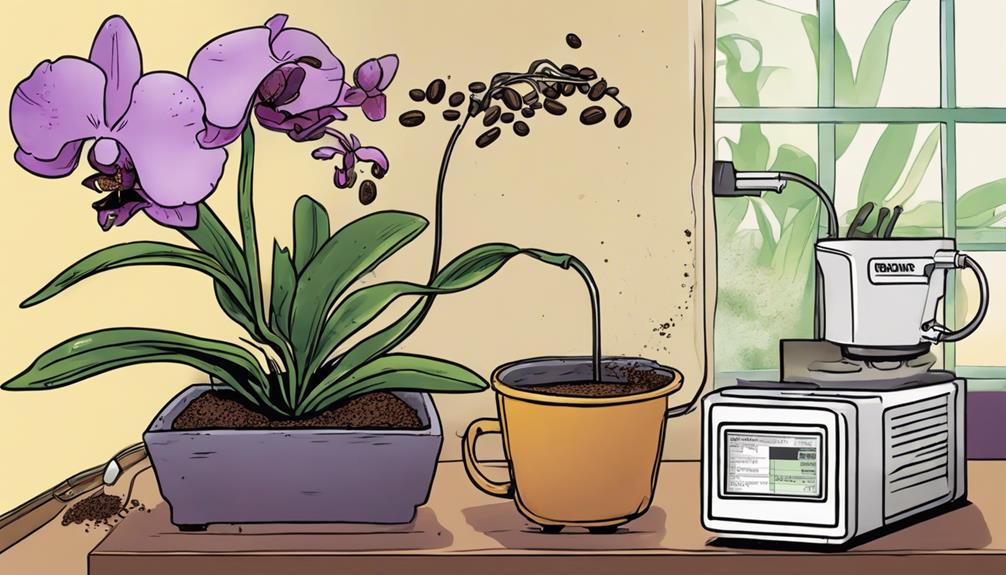
With the acidity of coffee grounds being an important factor, it's essential to address the potential acidification concerns when applying them to orchids. While recycling coffee grounds for your orchids may seem like a good idea, there are some key factors you need to know.
When you enjoy drinking coffee, the leftover grounds could be beneficial if used correctly. However, the acidic nature of coffee grounds can gradually decrease the pH of the orchid media over time. This increased acidity may hinder orchid growth and lead to issues with media decomposition.
Orchids may struggle to thrive in overly acidic media, impacting their health and development. Excessive watering combined with the acidity from coffee grounds can accelerate media decomposition, posing a risk to orchid roots.
Ultimately, the acidity introduced by coffee grounds could harm orchids by creating an environment unsuitable for their growth and well-being. Consider these acidification concerns before incorporating coffee grounds into your orchid care routine.
Pest Management Benefits
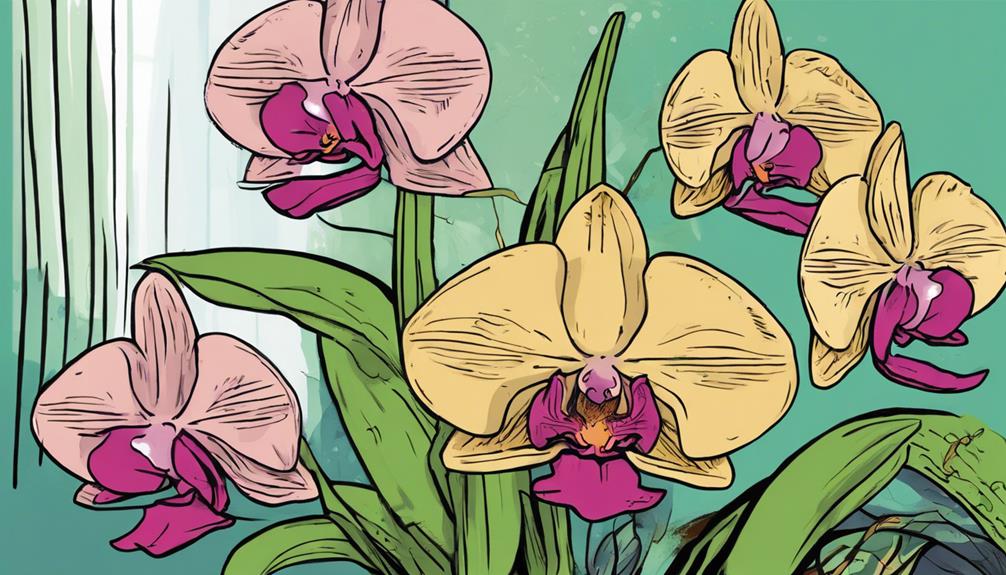
Coffee beans provide natural pest management benefits for orchids by deterring common pests like slugs, snails, whiteflies, and millipedes. When sprinkled on the orchid media surface, coffee grounds act as a natural repellent, keeping these unwanted insects at bay while maintaining proper drainage and aeration.
Unlike chemical insecticides, using coffee grounds offers a non-nutritional approach to pest control in orchid environments. By harnessing the pest-repelling properties of coffee grounds, orchids can thrive in a healthier, pest-free setting, promoting ideal growth conditions.
This eco-friendly solution not only helps manage pests effectively but also contributes to a more sustainable orchid care routine. Embracing coffee grounds as a pest management tool aligns with the principles of natural and environmentally conscious orchid care, ensuring a balanced and thriving orchid oasis for you to enjoy.
Orchid Suitability Factors
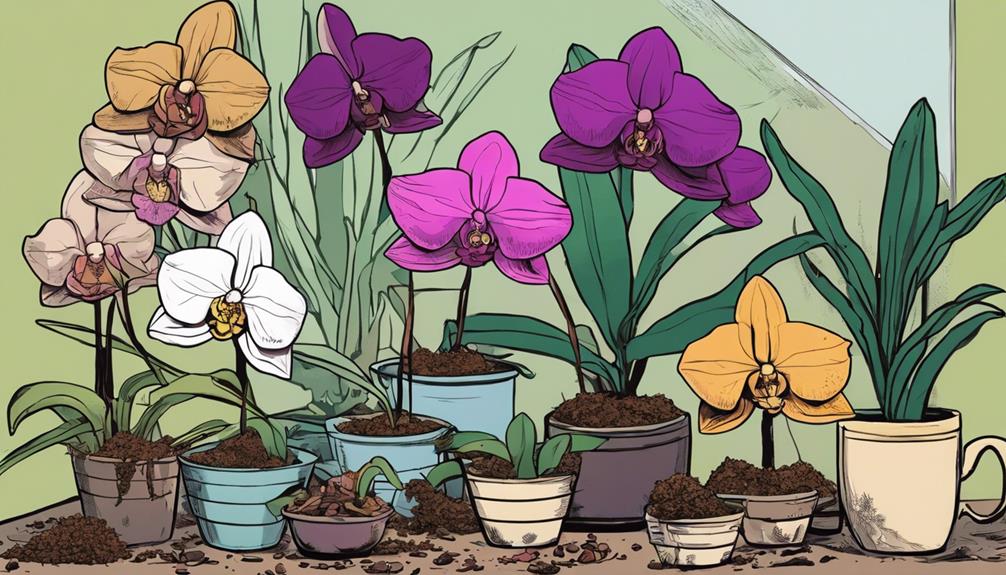
When considering applying coffee grounds to your orchids, it's vital to understand how different orchid types may interact with this amendment. Certain orchid types, such as Dendrobium and Cymbidium, may benefit from the nutrients found in coffee grounds, while others, such as Phalaenopsis and Vanda, could be sensitive to the acidity levels in the grounds. It is important to research the specific needs of your orchids before applying coffee grounds, and to start with a small amount to observe their reaction. If you do decide to apply coffee grounds, it is best to mix them with other organic material, such as coconut husk or bark, to help balance the pH levels and ensure the orchids receive a well-rounded source of nutrients.
The impact of coffee grounds on the pH of the growing media is another key factor to keep in mind when incorporating them into your orchid care routine.
Additionally, challenges related to nutrient uptake in potted orchids without soil microorganisms could affect the effectiveness of coffee grounds as a fertilizer.
Orchid Types and Coffee
Considering the suitability factors for orchids and coffee application involves evaluating the specific needs of different orchid types.
Epiphytic orchids grown in pots may not benefit from coffee grounds as they lack the necessary microorganisms for nutrient breakdown. On the other hand, ground orchids in gardens can thrive with the nutrients provided by coffee grounds.
However, potted orchids are more susceptible to issues like increased acidity and water retention when coffee grounds are used. Ground orchids, in particular, can benefit from coffee grounds by receiving essential nutrients and even aiding in pest control.
It's important to understand that the suitability of applying coffee grounds to orchids varies depending on the orchid type and its growing conditions. By considering these factors, you can determine whether coffee grounds are a fitting addition to your orchid care routine.
Media Ph Impact
Evaluate the impact of media pH on orchid suitability factors when using coffee grounds as part of your orchid care routine.
Coffee grounds, being acidic, can gradually lower the pH of the orchid media. This decrease in pH levels can impede the growth of orchids, making it challenging for them to thrive in a more acidic environment.
The acidity from the coffee grounds, when combined with excess water and poor air circulation, can hasten the decomposition of the media within the orchid pots. This accelerated breakdown of the media due to increased acidity can negatively affect the health of the orchid roots, further jeopardizing the well-being of the plant.
Hence, it's essential to monitor the pH levels of the orchid media when using coffee grounds to make sure that the acidity doesn't reach levels that could harm the orchids. Keeping a balanced pH level is vital for maintaining a healthy environment for your orchids to flourish.
Nutrient Uptake Challenges
To overcome nutrient uptake challenges faced by orchids when using coffee grounds, incorporating specific soil organisms becomes necessary for facilitating the transformation of coffee ground nutrients into forms accessible to the plants.
Orchids in pots lack the required soil microorganisms to break down nutrients in coffee grounds for absorption, which is further impeded by the absence of earthworms in traditional orchid mixes.
The nutrient content of coffee grounds requires the presence of specific soil organisms like bacteria and fungi to become usable by orchids. Without these essential microorganisms, potted orchids struggle to benefit from the nutrients present in coffee grounds.
The process of nutrient transformation in the soil, facilitated by these microorganisms, is critical for orchids to effectively utilize the nutrients provided by coffee grounds. Thus, ensuring the presence of the right soil organisms is essential for orchids to overcome the challenges related to nutrient uptake from coffee grounds.
Application Tips

When applying coffee grounds to orchids, remember to use them sparingly to avoid moisture-related issues that could harm your plants. Excess coffee grounds can lead to moisture retention, potentially suffocating the roots and causing rot. It's vital to ensure proper drainage in your orchid pots to prevent waterlogging from the moisture in the coffee grounds.
Additionally, using coffee grounds as a top dressing can help with pest control by repelling harmful insects like slugs and whiteflies. However, it's crucial to monitor the pH of the growing media regularly when incorporating coffee grounds, as their acidity levels can impact the growth and overall health of your orchids.
Consider the specific type of orchid you have before applying coffee grounds, as ground orchids may benefit more from this practice compared to potted epiphytic orchids.
Frequently Asked Questions
How to Apply Coffee Grounds to Orchids?
To apply coffee grounds to orchids, sprinkle a thin layer on the potting medium to deter pests. Avoid mixing fresh grounds in the potting mix to prevent moisture issues. Use grounds effectively in garden settings for better results. When using coffee grounds for gardenias, it’s important to remember that they prefer an acidic soil. Therefore, using coffee grounds as a top dressing for gardenias can help provide the acidic conditions they need to thrive. Be sure to monitor the pH levels of the soil to ensure it remains in the ideal range for gardenias.
Can Orchids Be Watered With Coffee?
You shouldn't water orchids with coffee. It can harm them by causing root suffocation, hindering nutrient absorption, and impacting their growth negatively. Stick to watering with proper orchid-friendly solutions for their health and well-being.
Do Orchids Like Instant Coffee?
Instant coffee is not ideal for orchids. They do not benefit from its lack of nutrients and beneficial microorganisms found in freshly brewed coffee. Opt for freshly brewed coffee grounds for healthier orchids.
What Is the Best Natural Fertilizer for Orchids?
For orchids, the best natural fertilizer is a balanced orchid-specific fertilizer designed for their unique needs. Guarantee proper moisture, light, and ventilation for healthy growth. Remember, not all natural options are ideal for your delicate orchids.
Conclusion
So next time you're enjoying your daily cup of joe, remember that those coffee grounds can also benefit your orchids in more ways than one.
Just a little sprinkle here and there can help with moisture retention, nutrient uptake, and even pest management.
So go ahead and give your orchids a little pick-me-up with some coffee grounds – they'll thank you with beautiful blooms in return.
Cheers to happy and healthy orchids!
